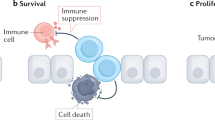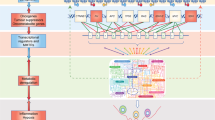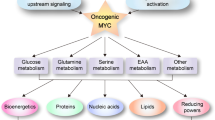Abstract
Cancer development involves major alterations in cells’ metabolism. Enhanced glycolysis and de novo fatty acids synthesis are indeed characteristic features of cancer. Cell proliferation and metabolism are tightly linked cellular processes. Others and we have previously shown a close relationship between metabolic responses and proliferative stimuli. In addition to trigger proliferative and survival signaling pathways, most oncoproteins also trigger metabolic changes to transform the cell. We present herein the view that participation of cell-cycle regulators and oncogenic proteins to cancer development extend beyond the control of cell proliferation, and discuss how these new functions may be implicated in metabolic alterations concomitant to the pathogenesis of human cancers.
This is a preview of subscription content, access via your institution
Access options
Subscribe to this journal
Receive 50 print issues and online access
$259.00 per year
only $5.18 per issue
Buy this article
- Purchase on Springer Link
- Instant access to full article PDF
Prices may be subject to local taxes which are calculated during checkout



Similar content being viewed by others
References
Abella A, Dubus P, Malumbres M, Rane SG, Kiyokawa H, Sicard A et al. (2005). Cdk4 promotes adipogenesis through PPARgamma activation. Cell Metab 2: 239–249.
Annicotte JS, Blanchet E, Chavey C, Iankova I, Costes S, Assou S et al. (2009). The CDK4–pRB–E2F1 pathway controls insulin secretion. Nat Cell Biol 11: 1017–1023.
Barthel A, Okino ST, Liao J, Nakatani K, Li J, Whitlock Jr JP et al. (1999). Regulation of GLUT1 gene transcription by the serine/threonine kinase Akt1. J Biol Chem 274: 20281–20286.
Bauer DE, Hatzivassiliou G, Zhao F, Andreadis C, Thompson CB . (2005). ATP citrate lyase is an important component of cell growth and transformation. Oncogene 24: 6314–6322.
Berwick DC, Hers I, Heesom KJ, Moule SK, Tavare JM . (2002). The identification of ATP-citrate lyase as a protein kinase B (Akt) substrate in primary adipocytes. J Biol Chem 277: 33895–33900.
Black AR, Black JD, Azizkhan-Clifford J . (2001). Sp1 and Kruppel-like factor family of transcription factors in cell growth regulation and cancer. J Cell Physiol 188: 143–160.
Brehm A, Miska EA, McCance DJ, Reid JL, Bannister AJ, Kouzarides T . (1998). Retinoblastoma protein recruits histone deacetylase to repress transcription. Nature 391: 597–601.
Buzzai M, Bauer DE, Jones RG, Deberardinis RJ, Hatzivassiliou G, Elstrom RL et al. (2005). The glucose dependence of Akt-transformed cells can be reversed by pharmacologic activation of fatty acid beta-oxidation. Oncogene 24: 4165–4173.
Cam H, Balciunaite E, Blais A, Spektor A, Scarpulla RC, Young R et al. (2004). A common set of gene regulatory networks links metabolism and growth inhibition. Mol Cell 16: 399–411.
Chen HZ, Tsai SY, Leone G . (2009). Emerging roles of E2Fs in cancer: an exit from cell cycle control. Nat Rev Cancer 9: 785–797.
Chiaradonna F, Sacco E, Manzoni R, Giorgio M, Vanoni M, Alberghina L . (2006). Ras-dependent carbon metabolism and transformation in mouse fibroblasts. Oncogene 25: 5391–5404.
Dali-Youcef N, Mataki C, Coste A, Messaddeq N, Giroud S, Blanc S et al. (2007). Adipose tissue-specific inactivation of the retinoblastoma protein protects against diabesity because of increased energy expenditure. Proc Natl Acad Sci USA 104: 10703–10708.
Daniel S, Kim KH . (1996). Sp1 mediates glucose activation of the acetyl-CoA carboxylase promoter. J Biol Chem 271: 1385–1392.
DeBerardinis RJ, Lum JJ, Hatzivassiliou G, Thompson CB . (2008). The biology of cancer: metabolic reprogramming fuels cell growth and proliferation. Cell Metab 7: 11–20.
Denechaud PD, Dentin R, Girard J, Postic C . (2008). Role of ChREBP in hepatic steatosis and insulin resistance. FEBS Lett 582: 68–73.
Dentin R, Pegorier JP, Benhamed F, Foufelle F, Ferre P, Fauveau V et al. (2004). Hepatic glucokinase is required for the synergistic action of ChREBP and SREBP-1c on glycolytic and lipogenic gene expression. J Biol Chem 279: 20314–20326.
Dimova DK, Dyson NJ . (2005). The E2F transcriptional network: old acquaintances with new faces. Oncogene 24: 2810–2826.
Drosten M, Dhawahir A, Sum EY, Urosevic J, Lechuga CG, Esteban LM et al. (2010). Genetic analysis of Ras signalling pathways in cell proliferation, migration and survival. EMBO J 29: 1091–1104.
Elstrom RL, Bauer DE, Buzzai M, Karnauskas R, Harris MH, Plas DR et al. (2004). Akt stimulates aerobic glycolysis in cancer cells. Cancer Res 64: 3892–3899.
Fabbrizio E, El Messaoudi S, Polanowska J, Paul C, Cook JR, Lee JH et al. (2002). Negative regulation of transcription by the type II arginine methyltransferase PRMT5. EMBO Rep 3: 641–645.
Fajas L, Egler V, Reiter R, Hansen J, Kristiansen K, Debril MB et al. (2002a). The retinoblastoma-histone deacetylase 3 complex inhibits PPARgamma and adipocyte differentiation. Dev Cell 3: 903–910.
Fajas L, Landsberg RL, Huss-Garcia Y, Sardet C, Lees JA, Auwerx J . (2002b). E2Fs regulate adipocyte differentiation. Dev Cell 3: 39–49.
Fajas L, Annicotte JS, Miard S, Sarruf D, Watanabe M, Auwerx J . (2004). Impaired pancreatic growth, beta cell mass, and beta cell function in E2F1(−/−) mice. J Clin Invest 113: 1288–1295.
Field SJ, Tsai FY, Kuo F, Zubiaga AM, Kaelin Jr WG, Livingston DM et al. (1996). E2F-1 functions in mice to promote apoptosis and suppress proliferation. Cell 85: 549–561.
Fritz V, Benfodda Z, Rodier G, Henriquet C, Iborra F, Avances C et al. (2010). Abrogation of de novo lipogenesis by SCD-1 inhibition interferes with oncogenic signaling, and blocks prostate cancer progression in mice. Mol Cancer Ther (in press).
Gottlob K, Majewski N, Kennedy S, Kandel E, Robey RB, Hay N . (2001). Inhibition of early apoptotic events by Akt/PKB is dependent on the first committed step of glycolysis and mitochondrial hexokinase. Genes Dev 15: 1406–1418.
Helin K . (1998). Regulation of cell proliferation by the E2F transcription factors. Curr Opin Genet Dev 8: 28–35.
Hsieh MC, Das D, Sambandam N, Zhang MQ, Nahle Z . (2008). Regulation of the PDK4 isozyme by the Rb–E2F1 complex. J Biol Chem 283: 27410–27417.
Iankova I, Petersen RK, Annicotte JS, Chavey C, Hansen JB, Kratchmarova I et al. (2006). Peroxisome proliferator-activated receptor gamma recruits the positive transcription elongation factor b complex to activate transcription and promote adipogenesis. Mol Endocrinol 20: 1494–1505.
Iglesias A, Murga M, Laresgoiti U, Skoudy A, Bernales I, Fullaondo A et al. (2004). Diabetes and exocrine pancreatic insufficiency in E2F1/E2F2 double-mutant mice. J Clin Invest 113: 1398–1407.
Jezek P, Plecita-Hlavata L, Smolkova K, Rossignol R . (2010). Distinctions and similarities of cell bioenergetics and the role of mitochondria in hypoxia, cancer, and embryonic development. Int J Biochem Cell Biol 42: 604–622.
Kim J, Lee JH, Iyer VR . (2008). Global identification of Myc target genes reveals its direct role in mitochondrial biogenesis and its E-box usage in vivo. PLoS One 3: e1798.
Kim JW, Zeller KI, Wang Y, Jegga AG, Aronow BJ, O′Donnell KA et al. (2004). Evaluation of myc E-box phylogenetic footprints in glycolytic genes by chromatin immunoprecipitation assays. Mol Cell Biol 24: 5923–5936.
Kim JW, Gao P, Liu YC, Semenza GL, Dang CV . (2007). Hypoxia-inducible factor 1 and dysregulated c-Myc cooperatively induce vascular endothelial growth factor and metabolic switches hexokinase 2 and pyruvate dehydrogenase kinase 1. Mol Cell Biol 27: 7381–7393.
Kroemer G, Pouyssegur J . (2008). Tumor cell metabolism: cancer's Achilles’ heel. Cancer Cell 13: 472–482.
Kuhajda FP, Jenner K, Wood FD, Hennigar RA, Jacobs LB, Dick JD et al. (1994). Fatty acid synthesis: a potential selective target for antineoplastic therapy. Proc Natl Acad Sci USA 91: 6379–6383.
Kuhajda FP . (2000). Fatty-acid synthase and human cancer: new perspectives on its role in tumor biology. Nutrition 16: 202–208.
Lewis BC, Prescott JE, Campbell SE, Shim H, Orlowski RZ, Dang CV . (2000). Tumor induction by the c-Myc target genes rcl and lactate dehydrogenase A. Cancer Res 60: 6178–6183.
Li F, Wang Y, Zeller KI, Potter JJ, Wonsey DR, O′Donnell KA et al. (2005). Myc stimulates nuclearly encoded mitochondrial genes and mitochondrial biogenesis. Mol Cell Biol 25: 6225–6234.
Li FX, Zhu JW, Tessem JS, Beilke J, Varella-Garcia M, Jensen J et al. (2003). The development of diabetes in E2f1/E2f2 mutant mice reveals important roles for bone marrow-derived cells in preventing islet cell loss. Proc Natl Acad Sci USA 100: 12935–12940.
Li J, Yen C, Liaw D, Podsypanina K, Bose S, Wang SI et al. (1997). PTEN, a putative protein tyrosine phosphatase gene mutated in human brain, breast, and prostate cancer. Science 275: 1943–1947.
Liu YC, Li F, Handler J, Huang CR, Xiang Y, Neretti N et al. (2008). Global regulation of nucleotide biosynthetic genes by c-Myc. PLoS One 3: e2722.
Lu S, Archer MC . (2009). Sp1 coordinately regulates de novo lipogenesis and proliferation in cancer cells. Int J Cancer 126: 416–425.
Magnaghi-Jaulin L, Groisman R, Naguibneva I, Robin P, Lorain S, Le Villain JP et al. (1998). Retinoblastoma protein represses transcription by recruiting a histone deacetylase. Nature 391: 601–605.
Majewski N, Nogueira V, Bhaskar P, Coy PE, Skeen JE, Gottlob K et al. (2004). Hexokinase-mitochondria interaction mediated by Akt is required to inhibit apoptosis in the presence or absence of Bax and Bak. Mol Cell 16: 819–830.
Manning BD, Cantley LC . (2007). AKT/PKB signaling: navigating downstream. Cell 129: 1261–1274.
Matoba S, Kang JG, Patino WD, Wragg A, Boehm M, Gavrilova O et al. (2006). p53 regulates mitochondrial respiration. Science 312: 1650–1653.
Mazurek S, Zwerschke W, Jansen-Durr P, Eigenbrodt E . (2001). Metabolic cooperation between different oncogenes during cell transformation: interaction between activated ras and HPV-16 E7. Oncogene 20: 6891–6898.
Medes G, Thomas A, Weinhouse S . (1953). Metabolism of neoplastic tissue. IV. A study of lipid synthesis in neoplastic tissue slices in vitro. Cancer Res 13: 27–29.
Menendez JA, Colomer R, Lupu R . (2005). Why does tumor-associated fatty acid synthase (oncogenic antigen-519) ignore dietary fatty acids? Med Hypotheses 64: 342–349.
Menendez JA, Lupu R . (2007). Fatty acid synthase and the lipogenic phenotype in cancer pathogenesis. Nat Rev Cancer 7: 763–777.
Moon YA, Kim KS, Cho UH, Yoon DJ, Park SW . (1999). Characterization of regulatory elements on the promoter region of human ATP-citrate lyase. Exp Mol Med 31: 108–114.
Morrish F, Neretti N, Sedivy JM, Hockenbery DM . (2008). The oncogene c-Myc coordinates regulation of metabolic networks to enable rapid cell cycle entry. Cell Cycle 7: 1054–1066.
Nadolski MJ, Linder ME . (2007). Protein lipidation. FEBS J 274: 5202–5210.
Osthus RC, Shim H, Kim S, Li Q, Reddy R, Mukherjee M et al. (2000). Deregulation of glucose transporter 1 and glycolytic gene expression by c-Myc. J Biol Chem 275: 21797–21800.
Porstmann T, Griffiths B, Chung YL, Delpuech O, Griffiths JR, Downward J et al. (2005). PKB/Akt induces transcription of enzymes involved in cholesterol and fatty acid biosynthesis via activation of SREBP. Oncogene 24: 6465–6481.
Porstmann T, Santos CR, Lewis C, Griffiths B, Schulze A . (2009). A new player in the orchestra of cell growth: SREBP activity is regulated by mTORC1 and contributes to the regulation of cell and organ size. Biochem Soc Trans 37: 278–283.
Ramanathan A, Wang C, Schreiber SL . (2005). Perturbational profiling of a cell-line model of tumorigenesis by using metabolic measurements. Proc Natl Acad Sci USA 102: 5992–5997.
Robey RB, Hay N . (2006). Mitochondrial hexokinases, novel mediators of the antiapoptotic effects of growth factors and Akt. Oncogene 25: 4683–4696.
Sabine JR, Abraham S, Chaikoff IL . (1967). Control of lipid metabolism in hepatomas: insensitivity of rate of fatty acid and cholesterol synthesis by mouse hepatoma BW7756 to fasting and to feedback control. Cancer Res 27: 793–799.
Sarruf DA, Iankova I, Abella A, Assou S, Miard S, Fajas L . (2005). Cyclin D3 promotes adipogenesis through activation of peroxisome proliferator-activated receptor gamma. Mol Cell Biol 25: 9985–9995.
Scaglia N, Igal RA . (2008). Inhibition of stearoyl-CoA desaturase 1 expression in human lung adenocarcinoma cells impairs tumorigenesis. Int J Oncol 33: 839–850.
Schwartzenberg-Bar-Yoseph F, Armoni M, Karnieli E . (2004). The tumor suppressor p53 down-regulates glucose transporters GLUT1 and GLUT4 gene expression. Cancer Res 64: 2627–2633.
Shim H, Dolde C, Lewis BC, Wu CS, Dang G, Jungmann RA et al. (1997). c-Myc transactivation of LDH-A: implications for tumor metabolism and growth. Proc Natl Acad Sci USA 94: 6658–6663.
Stiles B, Wang Y, Stahl A, Bassilian S, Lee WP, Kim YJ et al. (2004). Liver-specific deletion of negative regulator Pten results in fatty liver and insulin hypersensitivity [corrected]. Proc Natl Acad Sci USA 101: 2082–2087.
Tasdemir E, Maiuri MC, Galluzzi L, Vitale I, Djavaheri-Mergny M, D'Amelio M et al. (2008). Regulation of autophagy by cytoplasmic p53. Nat Cell Biol 10: 676–687.
Tong X, Zhao F, Mancuso A, Gruber JJ, Thompson CB . (2009). The glucose-responsive transcription factor ChREBP contributes to glucose-dependent anabolic synthesis and cell proliferation. Proc Natl Acad Sci USA 106: 21660–21665.
Vander Heiden MG, Cantley LC, Thompson CB . (2009). Understanding the Warburg effect: the metabolic requirements of cell proliferation. Science 324: 1029–1033.
Warburg O . (1930). Metabolism of Tumors. Arnold Constable: London.
Warburg O . (1956a). On the origin of cancer cells. Science 123: 309–314.
Warburg O . (1956b). On respiratory impairment in cancer cells. Science 124: 269–270.
Wieman HL, Wofford JA, Rathmell JC . (2007). Cytokine stimulation promotes glucose uptake via phosphatidylinositol-3 kinase/Akt regulation of Glut1 activity and trafficking. Mol Biol Cell 18: 1437–1446.
Wijesekara N, Konrad D, Eweida M, Jefferies C, Liadis N, Giacca A et al. (2005). Muscle-specific Pten deletion protects against insulin resistance and diabetes. Mol Cell Biol 25: 1135–1145.
Wofford JA, Wieman HL, Jacobs SR, Zhao Y, Rathmell JC . (2008). IL-7 promotes Glut1 trafficking and glucose uptake via STAT5-mediated activation of Akt to support T-cell survival. Blood 111: 2101–2111.
Xiong S, Chirala SS, Wakil SJ . (2000). Sterol regulation of human fatty acid synthase promoter I requires nuclear factor-Y- and Sp-1-binding sites. Proc Natl Acad Sci USA 97: 3948–3953.
Xue L, Gollapalli DR, Maiti P, Jahng WJ, Rando RR . (2004). A palmitoylation switch mechanism in the regulation of the visual cycle. Cell 117: 761–771.
Yamasaki L, Jacks T, Bronson R, Goillot E, Harlow E, Dyson NJ . (1996). Tumor induction and tissue atrophy in mice lacking E2F-1. Cell 85: 537–548.
Yamashita H, Takenoshita M, Sakurai M, Bruick RK, Henzel WJ, Shillinglaw W et al. (2001). A glucose-responsive transcription factor that regulates carbohydrate metabolism in the liver. Proc Natl Acad Sci USA 98: 9116–9121.
Yang YA, Han WF, Morin PJ, Chrest FJ, Pizer ES . (2002). Activation of fatty acid synthesis during neoplastic transformation: role of mitogen-activated protein kinase and phosphatidylinositol 3-kinase. Exp Cell Res 279: 80–90.
Acknowledgements
Members of the Fajas’ lab are acknowledged for support and discussions. This work was supported by grants from Agence Nationale pour la Recherche (ANR physio), Association pour la Recherche contre le Cancer, Institut National du Cancer (INCA) and Fondation pour la Recherche Médicale. VF was supported by a grant from the INCA.
Author information
Authors and Affiliations
Corresponding author
Ethics declarations
Competing interests
The authors declare no conflict of interest.
Rights and permissions
About this article
Cite this article
Fritz, V., Fajas, L. Metabolism and proliferation share common regulatory pathways in cancer cells. Oncogene 29, 4369–4377 (2010). https://doi.org/10.1038/onc.2010.182
Received:
Revised:
Accepted:
Published:
Issue Date:
DOI: https://doi.org/10.1038/onc.2010.182
Keywords
This article is cited by
-
Single-cell transcriptome analysis indicates fatty acid metabolism-mediated metastasis and immunosuppression in male breast cancer
Nature Communications (2023)
-
Metabolic modeling of host–microbe interactions for therapeutics in colorectal cancer
npj Systems Biology and Applications (2022)
-
Metabolic rewiring is associated with HPV-specific profiles in cervical cancer cell lines
Scientific Reports (2021)
-
Obscure Involvement of MYC in Neurodegenerative Diseases and Neuronal Repair
Molecular Neurobiology (2021)
-
Investigation of glucose catabolism in hypoxic Mcf 7 breast cancer culture
Cytotechnology (2021)



